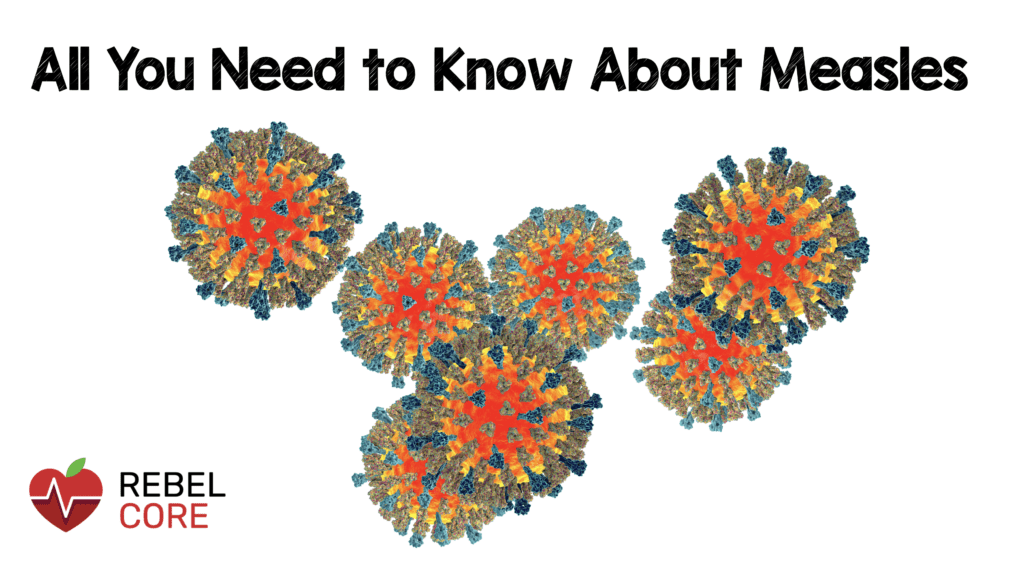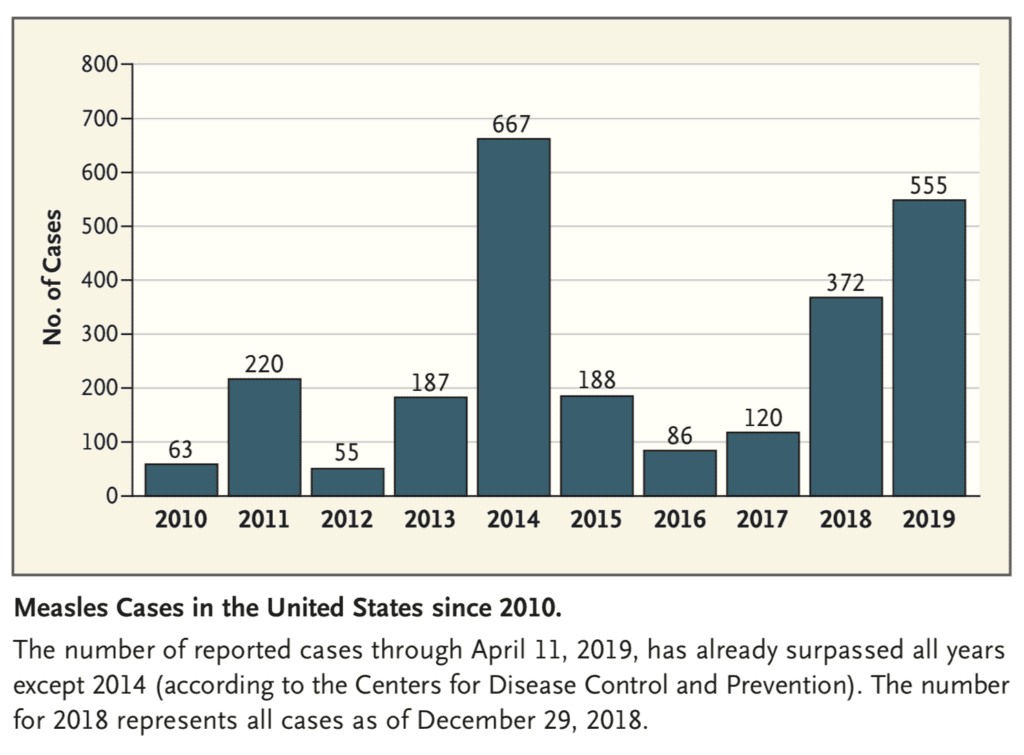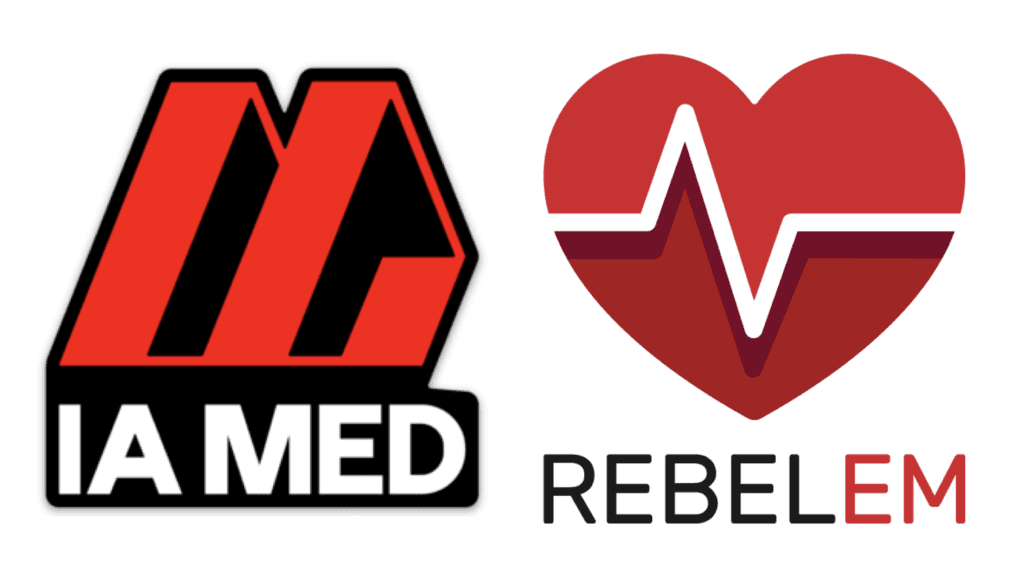
 Background: In 2000, the U.S. achieved the elimination of measles, defined as the absence of sustained transmission of the virus for more than 12 months [3,7]. Unfortunately, this success was short lived. According to the CDC, 555 cases of measles have already been confirmed from Jan 1st – April 11th, 2019 [3]. This resurgence in measles is frustrating as it has a safe and highly effective vaccine, and it has no animal reservoir to maintain circulation. Failure to get vaccinated unfortunately stems from misconceptions about vaccine safety (i.e. the now-debunked claim connecting vaccination to autism [4,5]), poor health education, lack of access to health care, and complacency. This is now a global epidemic as disease does not respect borders.
Background: In 2000, the U.S. achieved the elimination of measles, defined as the absence of sustained transmission of the virus for more than 12 months [3,7]. Unfortunately, this success was short lived. According to the CDC, 555 cases of measles have already been confirmed from Jan 1st – April 11th, 2019 [3]. This resurgence in measles is frustrating as it has a safe and highly effective vaccine, and it has no animal reservoir to maintain circulation. Failure to get vaccinated unfortunately stems from misconceptions about vaccine safety (i.e. the now-debunked claim connecting vaccination to autism [4,5]), poor health education, lack of access to health care, and complacency. This is now a global epidemic as disease does not respect borders.
Image from [3]
Epidemiology:
- Before the availability of an effective vaccine in 1963, measles was a ubiquitous disease [7].
- Worldwide, measles is the most common vaccine-preventable cause of death among children [1,3].
- Measles is one of the most contagious viral infections. Generally, all susceptible people exposed to an active case will acquire infection (i.e. Non-immune people have up to a 90% chance of contracting the disease [3,7]).
- The period of infectivity is typically 4 days prior to the onset of the rash and lasting up to 5 days following its appearance [7].
- Each person with measles could potentially go on to infect 9 – 18 more that are non-immune [3].
- Transmission: Respiratory Airborne
- Reservoir: Humans are the only natural host
Cause:
- Single stranded RNA virus
- 1 serotype
- Genus: Morbillivirus
- Family: Paramyxoviridae
Pathophysiology:
- Transmission of measles is primarily person-to-person via respiratory droplets that can be viable in the air for up to 2 hours. (Hence, healthcare workers should wear N95 masks while treating patients with suspected measles.)
- After multiplication in the respiratory mucosa, the virus spreads to regional lymphoid cells and then via the blood stream to leukocytes in the reticuloendothelial system.
- Erythematous maculopapular-to-confluent rash that first appears on the forehead and behind the ears and then spreads inferiorly to involve the face, trunk and extremities (including the palms and soles) reaching the feet by day 3.
Signs & Symptoms:
- Incubation period of 10 – 14 days.
- Most people infected will recover uneventfully after:
- Prodrome of high fever and URI symptoms (The 3 C’s: “barking” cough, coryza, conjunctivitis) occur 2 – 4 days prior to the appearance of the rash.
- Immunocompromised patients may never develop a rash [7].
- Koplik spots (white papules on an erythematous base) on the buccal mucosa are pathognomonic and precede the rash by 24 – 48 hours.
- However, measles can also lead to complications (greatest risk in immunosuppressed patients):
- Otitis media
- Diarrhea
- Keratoconjunctivitis (Measles can exacerbate vitamin A deficiency and lead to blindness).
- Pneumonia (the leading cause of measles-related deaths – 1 to 2/1,000) [3,7].
- Acute Disseminated Encephalomyelitis (ADEM) and Measles Inclusion-Body Encephalitis (1 in 1, 000 cases [3,7]) and result in permanent brain damage.
- Subacute Sclerosing Panencephalitis (SSPE) is a degenerative disease of the brain caused by measles, that can occur 7 – 10 years after measles virus infection. This occurs in 1 in 10,000 – 100,000 cases of measles [2,3].
- Mortality: Two of every 1000 children infected with measles will die from respiratory or neurologic complications [7].
- People at high risk for Complications [7]:
- Young children < 5 years
- Adults aged > 20 years
- Pregnant women
- Compromised immune systems (i.e. on chemotherapy, HIV infection, etc)
Acceptable Evidence of Immunity per the CDC [7]:
- Written documentation of adequate vaccination:
- One or more doses of measles-containing vaccine administered on or after the first birthday for preschool-age children and adults not at high risk.
- Two doses of measles-containing vaccine for school-age children and adults at high risk, including college students, healthcare personnel and international travelers.
- Laboratory evidence of immunity
- Laboratory confirmation of measles
- Birth before 1957
Testing:
- IgM antibody in serum and measles RNA by real-time polymerase chain reaction (RT-PCR) from a throat swab (or nasopharyngeal swab).
- Urine samples may also contain virus and when feasible, collect both a respiratory and urine sample to increase the likelihood of detecting the virus.
- The California Department of Public Health has a great PDF on testing specifics [Link is HERE]
Immediate Management:
- There is no specific antiviral therapy for measles.
- Treatment of the primary disease is supportive.
- Severe measles cases among children, such as those who are hospitalized should be treated with vitamin A (for prevention of keratoconjunctivitis blindness) and repeated again the next day:
- 50,000IU for infants younger than 6mos of age
- 100,000IU for infants 6 – 11 months of age
- 200,000IU for children 12 months of age and older
Prevention:
- Children: Primary prevention is via vaccination. All vaccines are highly effective (Up to 97% protection when given as 2 doses):
- 1st MMR dose at 12 – 15months of age
- 2nd MMR dose at school entry (4 – 6 years of age) or at least 28 days following the first dose
- Students at Post-High School Educational Institutions: Revaccination should occur in people entering educational institutions after high school or entering hospital service and have not had either a documented case of measles or the two-dose regimen
- Students at post-high school educational institutions without evidence of measles immunity need two doses of MMR vaccine, with the second dose administered no earlier than 28 days after the first dose
- Adults: People who are born during or after 1957 who do not have evidence of immunity against measles should get at least one dose of MMR vaccine
- International Travelers: People 6 months of age or older who will be traveling internationally should be protected against measles before traveling internationally:
- Infants 6 mos of age through 11 months of age should receive one dose of MMR vaccine
- Children 12 months of age or older should have documentation of two doses of MMR vaccine (the first does of MMR vaccine should be administered at age 12 months or older; the second dose no earlier than 28 days after the first dose)
- Teenagers and adults born during or after 1957 without evidence of immunity against measles should have documentation of two doses of MMR vaccine, with the second dose administered no earlier than 28 days after the first dose
Post-exposure prophylaxis (PEP):
- Provides permanent protection and may prevent disease if given within 72hours of exposure
- Except in health care settings, unvaccinated persons who receive their first dose of MMR vaccine within 72 hours post exposure may return to childcare, school, or work.
- People with profound immunosuppression cannot be safely vaccinated with the live-attenuated vaccine and must rely on herd immunity to protect them from measles (Infants younger than 12 months of age, pregnant women without evidence of measles immunity, and people with severely compromised immune systems, should receive IG).
- Immunoglobulin(IG) may prevent or modify disease if given within 6 days of exposure (Immunity provided by immunoglobulin is temporary)
- Standard immunocompetent patient ≥12mos of age = Immunoglobulin 0.5mL/kg IM (up to 15mL)
- Infants <12months of age = Immunoglobulin 0.5mL/kg IM (up to 15mL)
- Pregnant women without evidence of immunity or severely immunocompromised patients = Immunoglobulin 400mg/kg IV
- For infants aged 6 – 11 months MMR vaccine can be given in place of IG, if administered within 72 hours of exposure.
- Do not administer MMR vaccine and IG simultaneously, as this practice invalidates the vaccine.
- Severely immunocompromised patients include:
- Bone marrow or stem cell transplant until at least 12 months after finishing all immunosuppressive treatment, or longer where the patient has developed graft versus host disease
- Patients on treatment for ALL until at least 6 months after completion of immunosuppressive chemotherapy
- Patients with a diagnosis of AIDS or HIV-infected persons with CD4 <200 lymphocytes/mm3 and those who have not received MMR vaccine since receiving effective anti-retroviral therapy
- Some experts would include HIV infected persons who lack recent confirmation of immunologic status or measles immunity
Post Exposure Prophylaxis (PEP)

Image Modified from [8]
Isolation Time Based on Exposure

Image Created from Info on [7]
Take Home Points
- There is a resurgence of measles worldwide
- Incubation period is 10 – 14 days
- Patients are contagious 4 days before rash develops and up to 5 days after
- Acute treatment is primarily supportive
- Know the Post Exposure Prophylaxis (PEP) schedules and isolation times of various populations
- Healthcare workers should wear N95 masks while taking care of patients with suspected measles, and report cases to their local health department.
References:
- Tintinalli JE et al. Emergency Medicine: A Comprehensive Study Guide. McGraw-Hill 6th 2004.
- Marx JA et al. Rosen’s Emergency Medicine Concepts and Clinical Practice. Mosby Elsevier. 6th 2006.
- Paules CI et al. Measles in 2019 – Going Backward. NEJM 2019. PMID: 30995368
- Hviid A et al. Measles, Mumps, Rubella Vaccination and Autism: A Nationwide Cohort Study. Ann Intern Med 2019. PMID: 30831578
- Taylor LE et al. Vaccines are Not Associated with Autism: An Evidence Based Meta-analysis of Case-Control and Cohort Studies. Vaccine 2014. PMID: 24814559
- Cousins S. Measles: A Global Resurgence. Lancet Infect Dis 2019. PMID: 31002077
- CDC: Measles (Rubeola) for Healthcare Professionals. [Link is HERE]
- Tunis MC et al. Updated NACI Recommendations for Measles Post-Exposure Prophylaxis. Can Commun Dis Rep 2018. PMID: 31015814
For More on This Topic Checkout:
- First10EM: Measles – A Rapid Review
- ALiEM: Measles 2019 Updates – The Comeback Kid
Support the Show by Paying & Claiming 0.5hrs of CME/CEH by Clicking on the Logo Below
Post Peer Reviewed By: Mizuho Morrison, DO (Twitter: @mizspangler)
The post All You Need to Know About Measles appeared first on REBEL EM - Emergency Medicine Blog.



